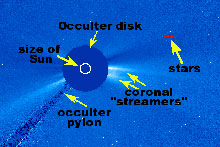The Coronagraph in Space: Forecasting Solar Activity to Protect Transportation, Communication, and Power Supply on Earth
- The Corona and Eclipse
- Coronal Mass Ejections
- Playing Havoc with Electronics
- Studying the Corona
- A Forecasting Breakthrough
The Sun's Corona and the Solar Eclipse

These images of the Sun's corona are from solar eclipses in 1980 (top left), 1988 (top right), 1991 (bottom left), and 1994 (bottom right) as observed on Earth. The Sun's changing magnetic fields determine the unique shapes of the corona.
Click image for larger view.
As early as 1307 B.C., ancients observed the Sun’s corona. Scientists did not begin to understand this phenomenon, however, until the mid-19th century while watching the solar eclipse. The beauty of a solar eclipse comes from the Sun's corona, which becomes visible when the moon passes between the Sun and Earth. The corona appears as streamers of light shining from around the Sun during an eclipse. But, it is actually the outermost layer of the solar atmosphere composed of very sparse but extraordinarily hot (800,000 to 3,000,000 degrees Kelvin or 1.4 million to 5.4 million degrees Fahrenheit) gas particles that are orders of magnitude hotter than the surface of the Sun! This outer atmosphere extends far beyond the Sun and even envelops the Earth.
Coronal Mass Ejections Hurtling Through Space
Occasionally, the Sun's atmosphere "explodes" causing material from the corona to be "ejected" into space. These coronal mass ejections (CMEs) can contain several billion tons of matter that can accelerate to several million miles per hour in a spectacular outburst of energy. Solar material streaks through space, interacting with any planets or spacecraft in its path. If this immense cloud of energized solar plasma encounters Earth's magnetic field, significant disruptions can result. CMEs are often, but not always, associated with solar flares, another type of solar activity. In addition, CMEs always stream outward from the Sun, but not always toward Earth.
Playing Havoc with Electronics on Earth

Coronal mass ejections sometimes disrupt communication signals on earth. Radio and television are not significantly affected, but shortwave, ground-to-air, ship-to-shore, military detection and early warning system communications can be. Click image for larger view.
Geomagnetic field disturbances on earth associated with these solar activities create the spectacular aurora (northern and southern lights). But, more ominously, they can play havoc with electronics on Earth by inducing electrical currents that damage power systems, disrupting communications, degrading high-tech navigation systems, and even accelerating pipeline corrosion if scientists and technicians are unable to take preventive action. NOAA’s Space Environment Center in Boulder, Colorado warns of solar-terrestrial events and continues to monitor solar activities. This service started during World War II when the Interservice Radio Propagation Laboratory in the National Bureau of Standards predicted the effects of solar activity on radio communications.
Studying the Corona

The coronagraph aboard this Solar and Heliospheric Observatory satellite is a dramatic breakthrough in NOAA space weather observers' ability to forecast the impact of coronal mass ejections on Earth. Click image for larger view.
To better study the corona, a French scientist, Bernard Lyot, invented the first coronagraph in 1930. The coronagraph is a special type of telescope that uses a solid disk (known as an occulter disk) to block direct sunlight and create an artifical eclipse for the observer peering through the instrument. Inventing the coronagraph marked the beginning of systematic study of the Sun’s corona. Today, satellites have improved NOAA’s ability to observe the corona and other solar phenomena and to forecast their impacts on electrical power distribution, communications, and electronics systems that result from geomagnetic field disturbances.
A Breakthrough in Solar Forecasting

Key features of an image from the LASCO coronagraph. Click image for larger view.
In 1995, NOAA scientists achieved a pivotal breakthrough in solar forecasting when NASA launched the Solar and Heliospheric Observatory (SOHO) spacecraft. The payload included a coronal imager called LASCO (Large Angle and Spectrometric Coronagraph Experiment). This instrument was the first to provide near real-time imagery of the solar corona from space over an extended period of time. Although NASA designed and operates SOHO for research purposes, NOAA quickly recognized the benefits of near real-time coronal imagery and developed procedures to analyze the images for space environment forecasting. With these new techniques, forecasters can determine the occurrence, direction and estimated speed of coronal mass ejections. Knowing these significantly improves forecasters’ ability to predict the beginning, strength, and length of a geomagnetic storm and possible disruptions of electronic equipment on earth.

These images from the LASCO coronal imager aboard the Solar and Helispheric Observatory spacecraft dramatically help forecasters predict how space weather will affect the Earth. Bright streaks to the left and right of center show a large coronal mass ejection (CME) coming from a solar flare. Click image for larger view.
An example of improved solar forecasting happened in October and November 2003, when the NOAA's Space Environment Center (SEC) observed several major solar flares during an elevated period of solar activity. When a powerful X17 solar flare1 occurred on October 28, 2003, SEC forecasters used LASCO coronagraph imagery to determine that an associated coronal mass ejection (CME) would impact earth, and that it would arrive within 24 hours. The CME caused significant geomagnetic storming within the forecast period, 19 hours after the initial observation.
The improvements enabled by the LASCO imager allow SEC to make more accurate forecasts so that power companies, major airlines, and satellite operators can take preventive measures to decrease risk to their systems. The techniques developed by SEC to take advantage of this real-time coronal imaging technology have had a profound and momentous impact on space weather forecasting.
1. Solar flares are classified as X, M, or C in magnitude. The letter X signifies the largest flares. The number indicates the relative size within the class. This flare was the fourth largest since 1976 at the time of observation.










